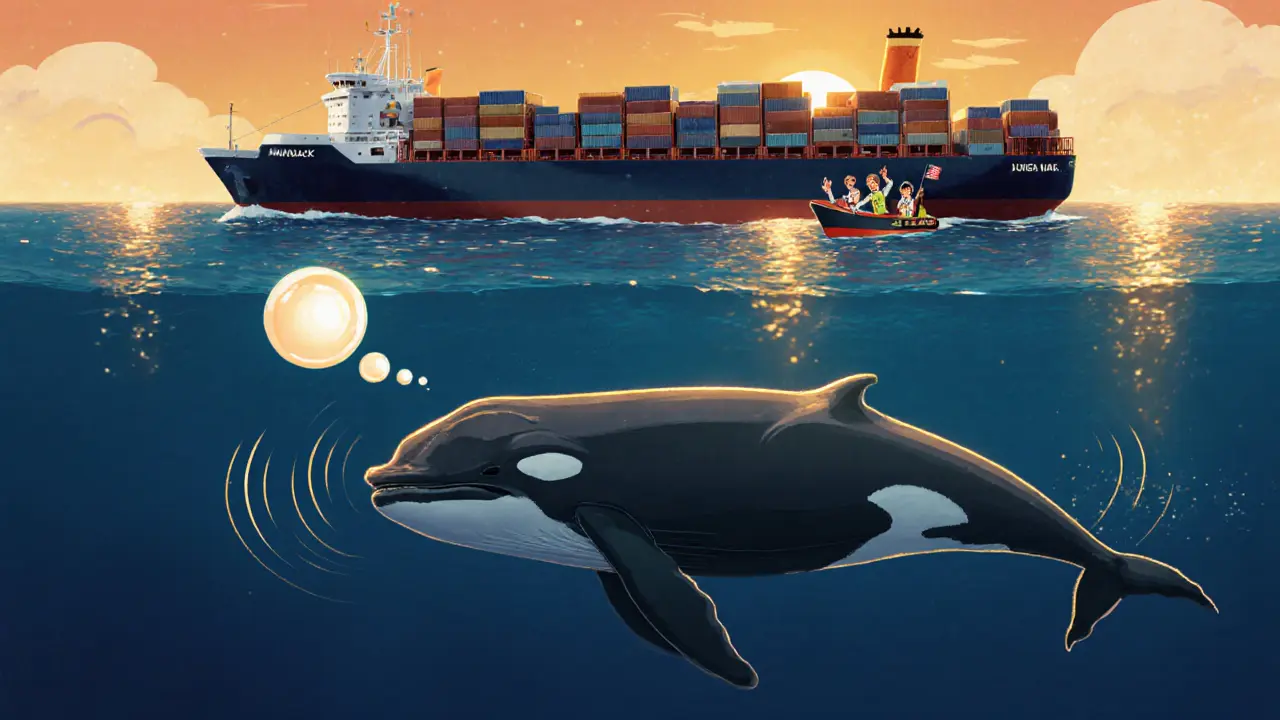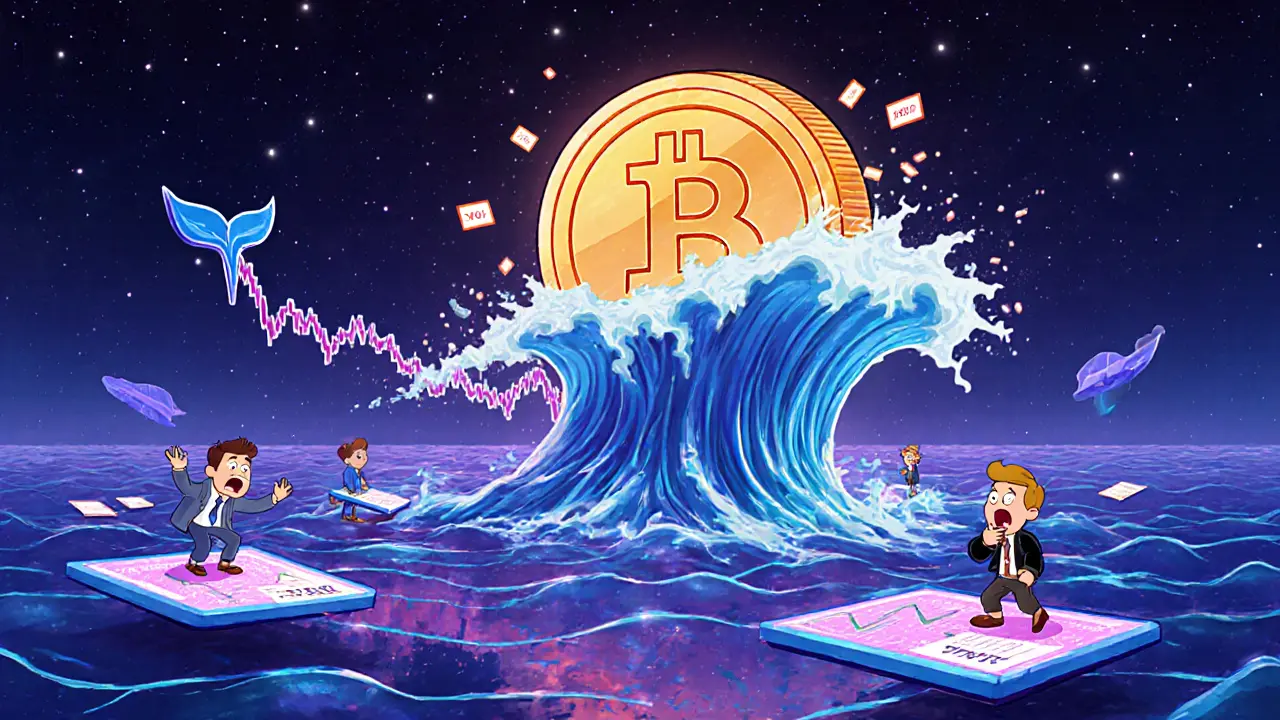Crypto Whale Transaction Impact Calculator
When you hear "whale alerts," you might think of ocean giants gliding through deep water. But in the world of cryptocurrency, "whales" are something else entirely - traders who hold millions, sometimes billions, of dollars in crypto. And when they move their coins, the market shakes. Whale alert services track these massive transactions in real time, giving traders a heads-up before prices swing. Meanwhile, across the ocean, another kind of whale alert is saving lives - not for profit, but for survival. Marine conservation systems use acoustic sensors and satellite data to warn ships when whales are nearby, preventing deadly collisions. Both systems use real-time notifications, but one drives trading decisions, and the other saves endangered species.
What Are Crypto Whale Alerts?
Crypto whale alerts are automated notifications that pop up when a large cryptocurrency transaction happens on the blockchain. These aren’t random transfers - they’re movements of $100,000 or more, often from exchanges like Binance or Coinbase, or from wallets tied to known institutional players. The goal? To spot big moves before they hit the market. If a whale sends $50 million in Bitcoin out of Coinbase to an unknown wallet, it could mean they’re preparing to sell. That kind of signal can trigger panic selling or FOMO buying, depending on how you interpret it.
Whale Alert, launched around 2019, is the most well-known service. It monitors over 1.2 million transactions daily across 16 blockchains. Its system normalizes data from different chains so you don’t need to track each one separately. It maps 85% of exchange addresses to known entities using clustering algorithms - meaning it can tell you if that big transfer came from Kraken, not just some random wallet. The alerts hit your phone, Telegram, Discord, or TradingView in under 15 seconds. That speed matters. In crypto, a 10-minute delay can mean missing a $2 million move.
How Do Whale Alerts Work Technically?
Behind the scenes, whale alert services run on high-performance infrastructure. They connect directly to blockchain nodes via WebSocket APIs, listening for raw transaction data. When a transfer hits a preset threshold - say, $1 million in ETH - the system checks if the sender or receiver is a known entity. If it is, it tags the alert with labels like "Coinbase Outflow" or "Binance Deposit." If it’s not, it flags it as "Unknown Wallet."
Free users get basic alerts with a limit of 10 per hour. Premium subscribers ($99/month) unlock lower thresholds ($10,000), historical data going back three years, and custom alerts for specific tokens or wallets. Enterprise clients (like Fidelity and Galaxy Digital) pay $499/month for API access, allowing them to embed alerts directly into their trading dashboards.
But it’s not perfect. About 37% of large transactions happen inside exchanges - meaning the whale moves coins from one internal wallet to another, and the alert service can’t see it. Another 12% of alerts are false positives: whales moving funds between their own wallets, not selling. One trader on Reddit lost 45 minutes chasing a USDC transfer that was just Circle rebalancing its reserves. Still, for many, the signal outweighs the noise.

Who Uses Whale Alerts and Why?
Whale alerts aren’t just for day traders. Hedge funds use them to spot liquidity shifts. Exchanges monitor them to manage reserve levels. Even retail traders rely on them as a market sentiment tool. One user on Trustpilot said a $1.2 billion BTC transfer out of Coinbase alerted him 17 minutes before the price dropped 8%. He made enough on a short position to cover his $99 monthly subscription 20 times over.
But the real power comes from context. A single alert doesn’t tell you if the whale is selling or just rebalancing. That’s why advanced users combine whale alerts with on-chain analytics from Glassnode or Santiment. Whale Alert gives you the "what" - the other tools give you the "why." Dr. Michiel Liffers of Glassnode says simple threshold alerts miss nuance, but crypto analyst Michaël van de Poppe argues immediacy trumps complexity: "When you see $500M leave an exchange, you don’t need a PhD to know something’s up."
Marine Whale Alerts: Saving Real Whales
Now, shift gears. On the other side of the world, "whale alerts" are saving lives. The Whale Report Alert System (WRAS), run by Ocean Wise with support from NOAA and IFAW, tracks real whales - humpbacks, right whales, finbacks - in North American waters. Every year, up to 20,000 whales die from ship strikes. WRAS uses a mix of aerial surveys, underwater microphones, and citizen reports to detect whales in real time. When one is spotted, the system sends alerts to ships within a 10-nautical-mile radius.
The system works on ECDIS navigation systems used by commercial vessels and has mobile apps for recreational boaters. Alerts arrive within two minutes of verification. In the Stellwagen Bank sanctuary, captains say the system prevented fatal collisions. One commercial skipper reported avoiding a right whale in November 2023 thanks to a real-time alert. NOAA’s 2023 study showed a 28% drop in ship-whale collisions in areas where WRAS was active.
But it’s not flawless. Accuracy drops to 63% in rough seas. The app has crashed during user reports, letting ships pass before the alert could be resent. Still, it’s the only system endorsed by both NOAA and Transport Canada. And with the International Maritime Organization requiring whale alert systems in critical habitats by 2027, adoption is accelerating.

Whale Alert vs. Whale Alert: A Stark Contrast
Both systems share the same name, the same real-time tech, and the same goal: to act on critical data before it’s too late. But that’s where the similarities end.
Crypto whale alerts are a commercial product. They’re built for profit, funded by subscriptions, and used by traders trying to outsmart the market. Whale Alert, the company, reported $12.3 million in revenue in 2023. It competes with Glassnode and Santiment, and its biggest asset is its social media reach - over 387,000 subscribers on Telegram, 1.4 million followers on Twitter.
Marine whale alerts are a public service. Funded by government grants ($4.7 million from NOAA in FY2024) and NGOs, they’re not for sale. Their success is measured in lives saved, not dollars earned. WRAS covers 100% of critical U.S. whale habitats and is expanding to the Pacific in late 2024. The EU is launching its own version, WhaleGuard, in Q3 2024.
One system thrives on volatility. The other thrives on calm. One needs constant user engagement. The other needs consistent funding. One is growing at 27% a year. The other at 8.7%. But both are essential.
What’s Next for Whale Alert Systems?
Crypto whale alerts are getting smarter. Whale Alert announced "Whale Intelligence" in June 2024 - an AI-powered platform that doesn’t just report transactions but predicts whale behavior. Is that whale moving coins because they’re exiting the market? Or are they preparing for a long-term hold? The new system tries to answer that. Beta testing starts in September 2024. They’re also adding Solana and Avalanche support by year-end.
Marine systems are going visual. Ocean Wise is testing AI-powered cameras on research vessels to identify whales from the air. In pilot tests, the system reached 92.7% accuracy in clear conditions. That’s a big leap from acoustic-only detection, which struggles in noisy ports.
But both face threats. Crypto whale alerts could be undermined by privacy coins like Monero and Zcash, which make transactions untraceable. They represent 4.3% of total crypto volume - small, but growing. Marine alerts face funding uncertainty. NOAA’s budget is political. Without sustained investment, the system could stall.
For now, both systems are working. Traders use whale alerts to stay ahead. Ships use them to avoid tragedy. Two worlds. One name. Two kinds of whales. Two kinds of alerts. And both are changing their worlds.
Are whale alerts reliable for trading crypto?
Whale alerts are useful but not foolproof. They show when large transactions happen, but not why. A $5 million ETH transfer could mean a whale is selling - or just moving funds between their own wallets. False positives happen about 12% of the time. Use them as a signal, not a strategy. Combine them with on-chain analytics for better context.
Can I get whale alerts for free?
Yes. Whale Alert offers a free tier that sends alerts for transactions over $100,000 with a limit of 10 per hour. You’ll get notifications via Twitter, Telegram, or email. But you won’t see historical data, custom thresholds, or enterprise API access. Premium ($99/month) unlocks lower thresholds, 3 years of history, and 24/7 support.
Do whale alerts work on all blockchains?
Most major services like Whale Alert track Bitcoin, Ethereum, Solana, BSC, and others - around 16 blockchains total. But not all. Privacy chains like Monero and Zcash are intentionally opaque and won’t appear in alerts. Smaller chains may not be covered unless the service adds them. Always check the supported blockchains before subscribing.
How do marine whale alerts prevent ship collisions?
Marine whale alerts use acoustic sensors, aerial surveys, and citizen reports to detect whales in real time. When a whale is confirmed, the system sends an alert to ships within 10 nautical miles via ECDIS navigation systems or mobile apps. Ships can then slow down, change course, or increase vigilance. In areas where the system is active, ship-whale collisions have dropped by up to 28%.
Is the Whale Alert app for marine conservation free?
Yes. The Whale Report Alert System (WRAS) mobile app is free for iOS and Android. It’s designed for recreational boaters and doesn’t require a subscription. Commercial vessels integrate the system into their ECDIS navigation tools, which are often part of mandatory safety equipment. The system is funded by NOAA and NGOs, not users.
What’s the difference between Whale Alert and Glassnode?
Whale Alert focuses on real-time notifications of large transactions. Glassnode provides deep on-chain analytics - like exchange net flows, miner behavior, and long-term holder activity. Whale Alert tells you "what happened." Glassnode tells you "what it means." Many traders use both: Whale Alert for urgency, Glassnode for insight.
Can whale alerts predict market crashes?
Not directly. Whale alerts show movement, not intent. A large outflow from an exchange might signal a sell-off - but it could also be a hedge fund rebalancing. Market crashes are caused by many factors: macro news, regulatory changes, liquidity crunches. Whale alerts are one piece of the puzzle, not a crystal ball.
Are whale alerts used by regulators?
In crypto, regulators don’t use whale alerts directly, but they monitor them. The EU’s MiCA framework requires exchanges to report large transactions starting in late 2024. Whale alert data helps compliance teams spot suspicious activity. In marine conservation, NOAA and Transport Canada formally endorse WRAS and require its use in critical habitats by 2025.

Cody Leach
November 14, 2025 AT 09:51Whale alerts are useful but they're not magic. I've seen too many people chase $50M BTC moves only to get rekt because the whale was just moving funds between their own wallets. Real trading needs context, not just alerts.
Mandy Hunt
November 16, 2025 AT 07:23theyre watching us dont you get it the whales arent just traders theyre controlled by the fed and the cia they use these alerts to manipulate retail traders into buying so they can dump on us i saw it happen in 2021 and its happening again
anthony silva
November 18, 2025 AT 04:54so you paid 99 bucks to get a text when someone moves a million dollars? wow. youre a genius. next youll pay extra to get notified when the sun rises.
David Cameron
November 19, 2025 AT 21:20both systems are mirrors. one reflects greed the other reflects care. we build tools to survive but we forget why we built them in the first place. one saves a life the other feeds a portfolio. which one are you feeding?
Sara Lindsey
November 21, 2025 AT 12:16YES THIS IS SO POWERFUL I JUST GOT MY FIRST WHALE ALERT AND I MADE 20K IN 10 MINUTES I CANT BELIEVE THIS IS REAL LIFE LIKE OMG THANK YOU POST I JUST QUIT MY JOB
alex piner
November 22, 2025 AT 07:55man i love how this post connects two totally different worlds. whales in the ocean and whales in crypto. its wild how tech can be used to hurt or to heal. keep this kind of stuff coming
Kandice Dondona
November 22, 2025 AT 08:52so cool!! 🌊🐳✨ i just downloaded the whale alert app for boating and i feel like a real ocean hero now. also got the crypto alerts too bc why not?? 🚀💰 you guys are doing amazing work
Becky Shea Cafouros
November 22, 2025 AT 14:32The notion that these systems are comparable is a fallacy. One is a market tool, the other a conservation protocol. The equivalence is rhetorical, not functional. Please do not conflate utility with symbolism.
Liz Watson
November 24, 2025 AT 10:18Of course you'd pay $99/month for alerts. You're the kind of person who buys 'luxury' coffee beans labeled 'single-origin, hand-picked by monks in Nepal.' The whale alerts are a luxury scam. The real whales? They're laughing at you.
Rachel Anderson
November 24, 2025 AT 20:55WHEN I FIRST SAW THAT $500M BTC MOVE I FELT LIKE I WAS WATCHING A DOCUMENTARY ABOUT THE END OF THE WORLD. I SCREAMED. MY CAT JUMPED OFF THE COUCH. I DIDNT SLEEP FOR THREE HOURS. THATS THE POWER OF WHALES.
Hamish Britton
November 25, 2025 AT 04:13interesting how both systems rely on real-time data. reminds me of when i used to track my mum's bus on the app just to know when she'd be home. same tech, different stakes.
Robert Astel
November 26, 2025 AT 04:59you know what i think its not just about the alerts its about the human need to feel like we can predict chaos right like we all want to believe there's a pattern in the madness the whales are just the latest version of reading tea leaves or tarot cards but with blockchain and sonar instead of candles and crystals and honestly its kinda beautiful in a weird way
Andrew Parker
November 27, 2025 AT 02:47the real whale is the system itself. the alerts are just the bubbles it leaves behind. we're all just fish swimming in its wake, thinking we're smart because we got a notification. but who made the whale? who feeds it? who owns the data? you think you're ahead? you're just the bait.
Kevin Hayes
November 28, 2025 AT 02:41There is a fundamental asymmetry in purpose. One system optimizes for financial gain; the other for ecological preservation. The former is commodified; the latter, communal. The convergence of terminology is coincidental, not conceptual. The metaphor is seductive but misleading.
Katherine Wagner
November 29, 2025 AT 02:37whale alerts are useless.. theyre always wrong.. i mean look at last week.. $300M out of binance.. panic sell.. then it was just a guy moving funds to his cold wallet.. and marine alerts? they crash when you need them most.. i saw a whale pass right by a boat.. app said nothing.. so yeah..
Drew Monrad
November 30, 2025 AT 13:21you think crypto whales are scary? try being a humpback in the shipping lane and watching a 300,000-ton cargo ship ignore your 100-decibel SOS. one alerts people to make money. the other alerts people to not kill something older than the pyramids. and you're mad because you lost $500 on a false alert? cry harder.
sandeep honey
December 1, 2025 AT 09:53why dont we just merge both systems? imagine if crypto whales had to pay a carbon tax every time they moved coins and the money went to whale conservation. that would be genius. make greed fund empathy. now thats a blockchain i want to invest in.